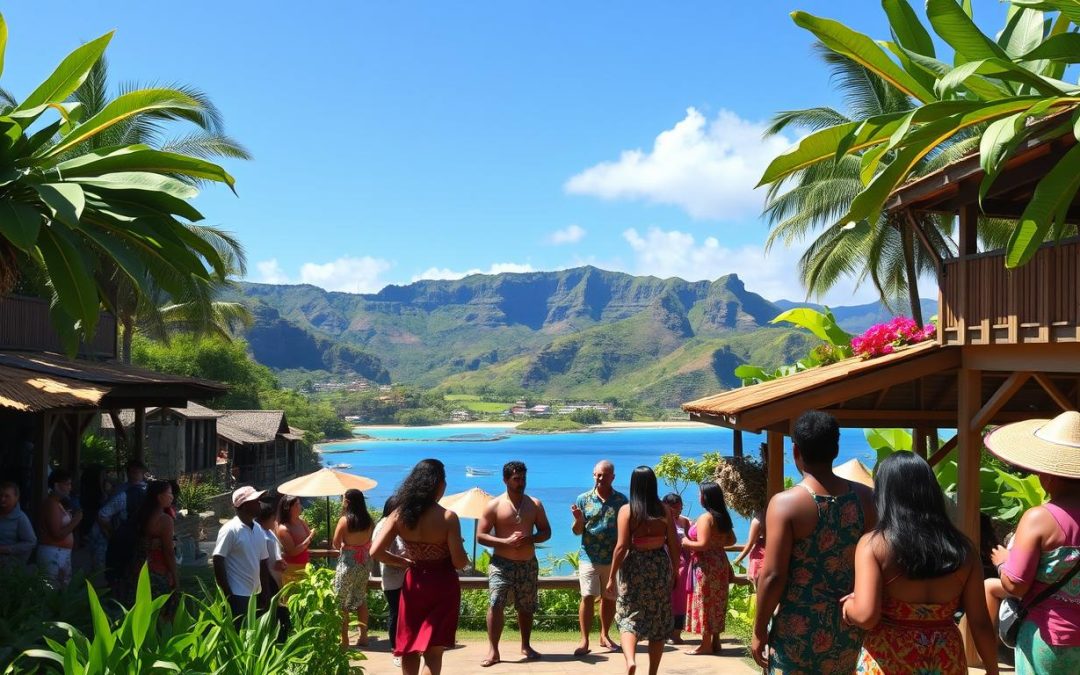Have you ever thought about how a small Pacific island nation blends three languages into its culture? Fiji is a great example of this, with English, Fijian, and Fiji Hindi as official languages. These languages tell a story of cultural mix and history.
Since 1997, Fiji has celebrated its multilingual identity. Indigenous Fijians, making up 54% of the population, mainly speak Fijian. Indo-Fijians, who are 37% of the population, mostly use Fiji Hindi.
The language scene in Fiji is more than just talking. It shows the island’s complex history. With the Fijian language spoken by about 600,000 people and English used in government and business, Fiji shows amazing language strength.
Key Takeaways
- Fiji has three official languages: English, Fijian, and Fiji Hindi
- Around 54% of the population are indigenous Fijian speakers
- English serves as a lingua franca in professional sectors
- The Fijian language has approximately 600,000 total speakers
- Linguistic diversity represents Fiji’s rich cultural heritage
Understanding Fiji’s Linguistic Landscape
Explore Fiji’s world of language diversity. Here, languages share stories of cultural mix and historical change. Fiji is a mix of indigenous languages and cultural expressions, showing its complex heritage.
The Evolution of Language in Fiji
Before the 19th century, Fiji was mostly home to indigenous Fijians. The language scene changed a lot with colonial rule and new arrivals. Important changes include:
- English was introduced during colonial times
- Fiji Hindi came with indentured laborers
- Indigenous languages were kept alive
Current Language Demographics
Now, Fiji is known for its language variety. The main languages are:
- iTaukei (Indigenous Fijian)
- Fiji Hindi
- English
“Languages are the roadmaps of a culture. They tell you where its people come from and where they are going.” – Rita Mae Brown
Impact of Cultural Diversity
Fiji’s society is multilingual, showing great language flexibility. Most people speak two or three languages, with indigenous languages key to keeping culture alive. In cities, English is common, but in rural areas, traditional languages are stronger.
Now, the government works to keep Fiji’s language heritage alive. This helps Fiji’s languages thrive in today’s global world.
English in Fiji: From Colonial Language to Modern Communication
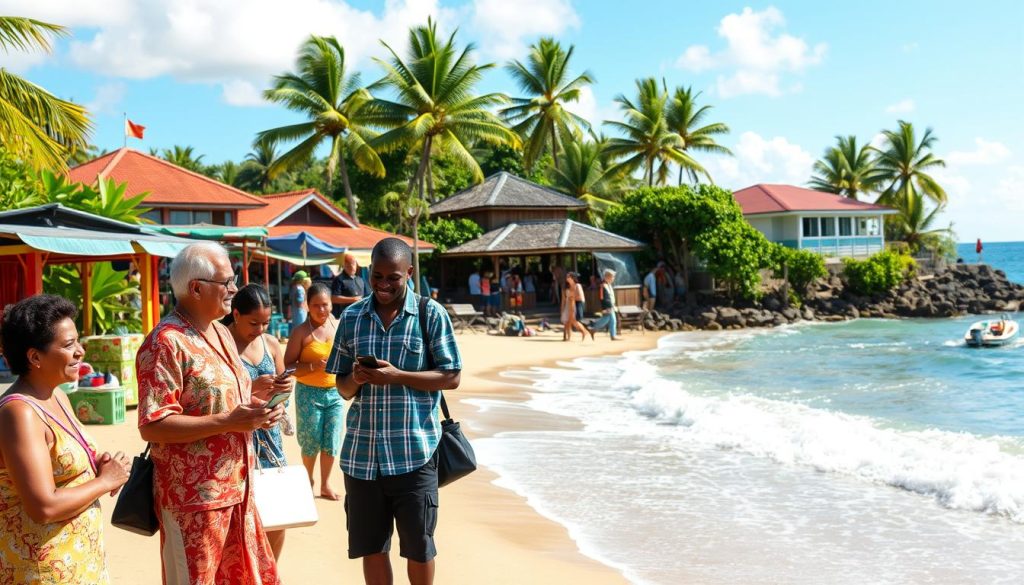
Exploring Fiji’s language history shows how English evolved. It started as a language brought by British explorers. Over time, it became a key part of Fijian life.
In Fiji, English is vital for education and talking to others. Though only 3% speak English first, it’s the main language in schools. By Class 3, kids switch to English in school.
“Language is the roadmap of a culture. It tells you where its people come from and where they are going.” – Rita Mae Brown
Fiji’s language scene is rich and varied. English connects different cultures in the country. In cities and tourist spots, it’s easy to communicate with others.
- Official language since 1970 independence
- Primary language for administration and law
- Essential for business and higher education
- Supports cross-cultural communication
Fiji English is a special dialect that shows how language changes. It mixes local and English words, showing English’s flexibility in different cultures.
English in Fiji is more than a language. It connects people from different backgrounds, helping them understand each other.
The Fijian Language: Heart of Indigenous Culture
Explore the vibrant world of the Fijian language. It’s a key part of Fiji’s culture. With about 400,000 speakers, it shows the heart of Fijian identity.
The Fijian language is a symbol of Fiji’s rich language diversity. It became an official language in 1997. It shows the importance of keeping indigenous culture alive.
Bauan Dialect: A Linguistic Powerhouse
The Bauan dialect is the standard Fijian language. It connects different areas of Fiji. It shows how indigenous languages keep cultures strong.
- Consists of two major dialect subgroups: Western and Eastern
- Features a unique Verb-Object-Subject (VOS) word order
- Includes 16 distinct consonants and 5 basic vowels
Regional Linguistic Variations
There are many variations across Fiji’s 110 islands. Each one tells a story of local culture and traditions.
Preserving Language in Modern Times
Today, the Fijian language is still changing. Even though only 50% of Fijians speak it first, efforts to save it are strong. It’s used in ceremonies and music, keeping Fijian culture alive.
“Language is the road map of a culture. It tells you where its people come from and where they are going.” – Rita Mae Brown
Fiji Hindi: A Unique Cultural Blend
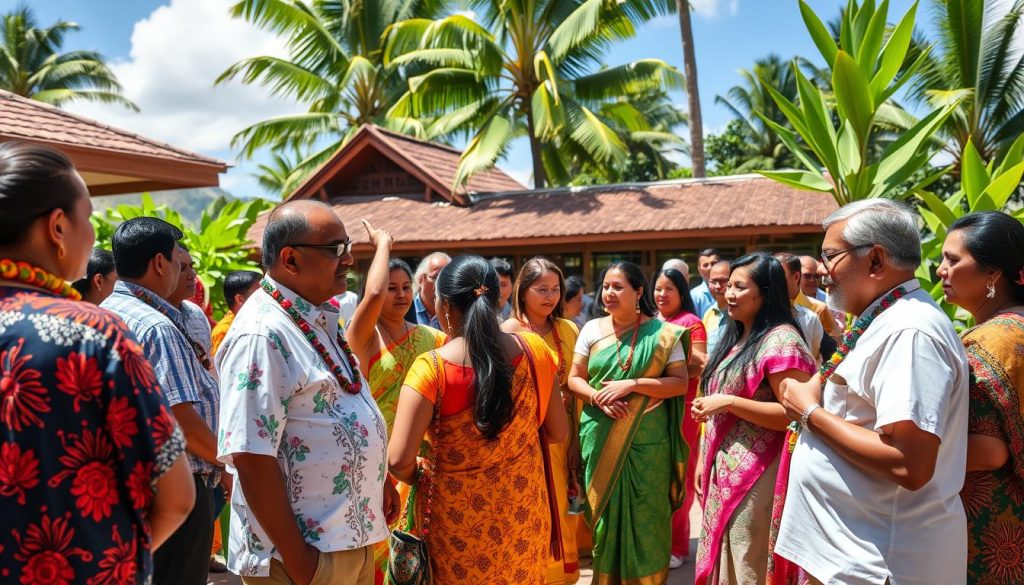
In 1879, the first Indian indentured laborers arrived in Fiji. They brought a language treasure that changed the island’s culture. Fiji Hindi was born from need, survival, and cultural adaptation.
This language is a journey of linguistic diversity. It comes from Awadhi and Bhojpuri dialects, with influences from Fijian and English. It became a special way for about 60,000 Indian laborers to communicate.
“Fiji Hindi is more than a language – it’s a living testament to cultural resilience and adaptation.”
What makes Fiji Hindi special includes:
- It started from many Indian regional languages
- It has words from Fijian and English
- It’s mainly spoken by Indo-Fijians
- It’s a primary language at home
A 2017 study found that 23.1% of students use Fiji Hindi as their main language. Despite its rich history, it faces challenges. There’s no standard writing script, and it’s not widely recognized in schools.
Learning about Fiji Hindi lets you see Fiji’s complex cultural mix. It shows how languages grow through history and community creativity.
Language Policies and Educational System
Fiji’s language scene is a mix of cultures and learning strategies. The country’s language policies show its rich cultural mix and the need to keep languages diverse in schools.
Exploring Fiji’s language policies is like a journey of keeping cultures alive and talking to each other. Schools play a big part in supporting Fiji’s many languages.
Language Instruction in Schools
Fiji’s schools teach languages in a special way. The main policy is to learn many languages. It includes:
- Teaching in the mother tongue for the first three years of primary school
- Using English as the main teaching language after the first years
- Helping Fijian and Fiji Hindi languages
Government Language Initiatives
The government has started new projects to keep languages alive. A big step was when Prime Minister Sitiveni Rabuka let vernacular languages be used in Parliament in 2022. This shows the government’s dedication to including all languages.
“Language is the roadmap of a culture. It tells you where its people come from and where they are going.” – Rita Mae Brown
Parliamentary Language Dynamics
The language rules in Fiji’s Parliament show the country’s support for many languages. With English, Fijian, and Fiji Hindi as official languages, the government makes sure everyone’s voice is heard.
Learning about Fiji’s language policies shows a careful balance in education and keeping cultures alive. The system keeps native languages strong while teaching English for global communication.
Minority Languages and Their Role in Fijian Society
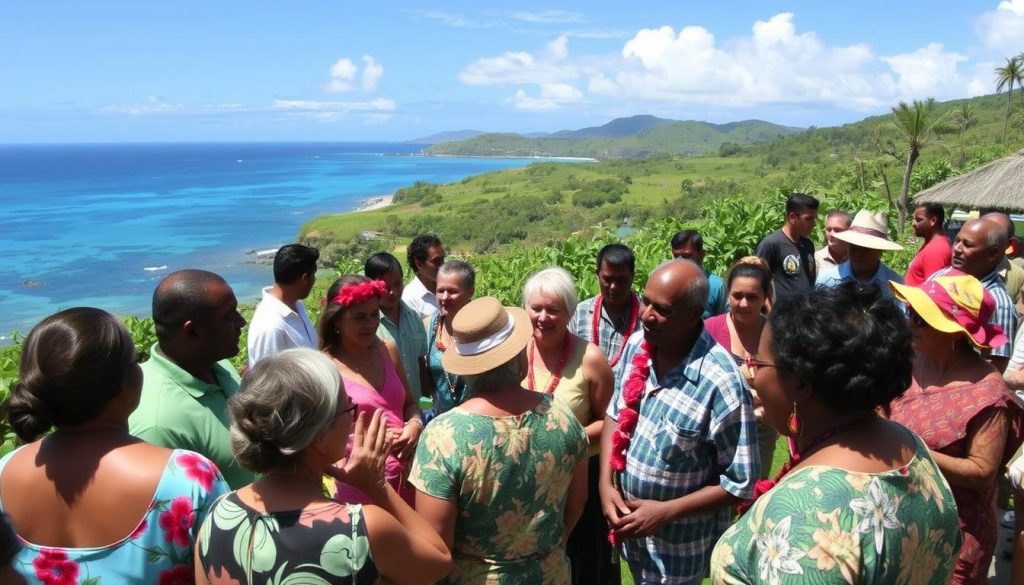
Fiji is home to more than just three official languages. Its rich culture shows a variety of minority languages. These languages tell the story of Fiji’s history and people.
In Fiji, you’ll find many interesting languages:
- Rotuman language from the Rotuma Island
- Indian languages like Tamil, Telugu, Punjabi, and Gujarati
- Chinese dialects spoken by immigrant communities
- Polynesian language variants
These languages are more than just a way to talk. They hold the culture and history of Fiji’s people. Families keep their languages alive, even as they use English to connect with others.
“Language is the roadmap of a culture. It tells you where its people come from and where they are going.” – Rita Mae Brown
Keeping these languages alive is hard. Young people often prefer English over their native tongues. But, groups and organizations work hard to keep Fiji’s languages alive. They offer classes, events, and help document these languages.
Learning about Fiji’s languages shows a vibrant culture. Here, many languages live together, making Fiji’s identity special.
The Impact of Multilingualism on Fiji’s Cultural Identity
Fiji’s language scene is a colorful mix of different cultures. Being a multilingual society, it shows how language shapes who we are. With Indo-Fijians and indigenous Fijians making up nearly the whole population, the language diversity is stunning.
Social Integration Through Language
Language is a strong link between Fiji’s communities. Studies reveal that Fijians are amazingly good at speaking many languages:
- 96.6% of Fijian students are multilingual
- 94.6% of children aged 5-11 speak more than one language
- 17.6% of children speak more than four languages
Cultural Preservation Efforts
Keeping Fiji’s languages alive is vital for its culture. Schools play a big part, starting with teaching in the mother tongue. Fijian and English are key for talking between different groups, helping to keep cultural richness alive.
Language in Traditional Ceremonies
“Language is the road map of a culture. It tells you where its people come from and where they are going.” – Rita Mae Brown
Traditional ceremonies in Fiji show the deep link between language and culture. They use standard Hindi, Bauan Fijian, and local dialects. These languages keep Fiji’s traditions lively and meaningful.
Modern Language Trends and Digital Communication
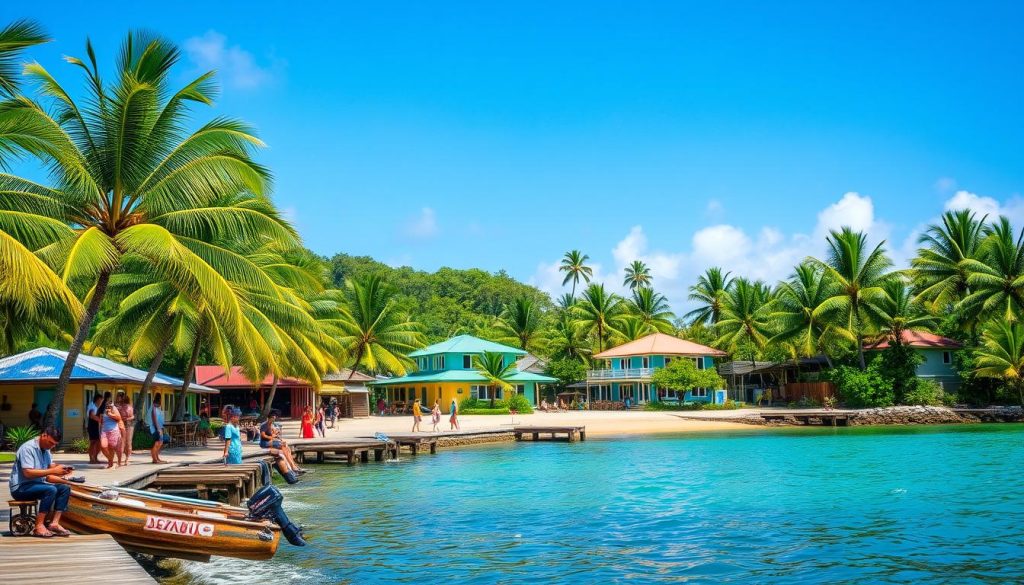
Digital communication is changing how Fijians talk and share ideas. Fiji’s language scene is now more vibrant than ever. It’s all thanks to technology, which has become a key way to communicate.
Social media and messaging apps are where Fijian, English, and Fiji Hindi meet. Young people in Fiji are making new digital language styles. These styles show off their mixed cultural backgrounds.
- Multilingual text messaging
- Social media posts mixing languages
- Online content in local languages
- Digital slang and internet terminology
The digital world has brought new ways of speaking. Code-switching between languages is now common, especially among the young. They easily move between different languages.
“Language is not static; it’s a living, breathing entity that adapts to technological changes.” – Linguistic Researcher
More people have smartphones and internet access. This has sped up changes in language. Online, there are new chances to keep Fiji’s languages alive and to express creativity.
Language Challenges and Future Prospects
Fiji’s language scene is at a turning point. It’s all about keeping cultural identity alive while moving forward with technology.
There’s a big difference in how people speak in cities versus rural areas. Cities are moving towards English, but rural areas hold tight to their traditional tongues.
Urban vs Rural Language Dynamics
Knowing about Fiji’s language journey is key. In cities, you see a big move towards speaking many languages. This is because of:
- More English classes
- Digital tools changing how we talk
- Less focus on keeping old dialects alive
Technology’s Language Evolution
Technology is changing how we keep languages alive. Apps, online tools, and social media are helping to keep Fiji’s languages diverse.
“Languages are living entities that adapt or fade away” – Linguistic Researcher
Preservation Strategies for the Future
New ways are being found to save Fiji’s languages. Community efforts, school programs, and tech help are key to keeping languages alive.
- Creating digital content in many languages
- Building language learning websites
- Helping document indigenous languages
Even though only 3% speak English first, Fiji is dedicated to its languages. The country’s language plans keep changing, making sure culture stays vibrant in a global world.
Conclusion
Your journey through Fiji’s linguistic landscape shows a remarkable multilingual society. This society reflects the nation’s rich cultural tapestry. Fiji is a unique example of linguistic diversity, with three official languages: English, Fijian, and Fiji Hindi.
The language ecosystem in Fiji is more than just communication. It’s a living testament to the country’s complex history. Indigenous Fijians, Indo-Fijians, and other ethnic groups contribute to a vibrant linguistic mosaic. Despite challenges like language extinction, Fiji protects and celebrates its linguistic heritage.
Language in Fiji is a bridge connecting communities and preserving cultural identities. It reflects the nation’s resilience. From Suva’s bustling streets to remote islands, each conversation echoes generations. This shows that linguistic diversity is a treasure worth protecting and celebrating.
Your understanding of Fiji’s language landscape now goes beyond words. It offers a deep insight into how communication shapes cultural identity in this remarkable Pacific island nation.
The above is subject to change.
Check back often to TRAVEL.COM for the latest travel tips and deals.
Here are some Tours & Sightseeing suggestions that might pique your interests!
